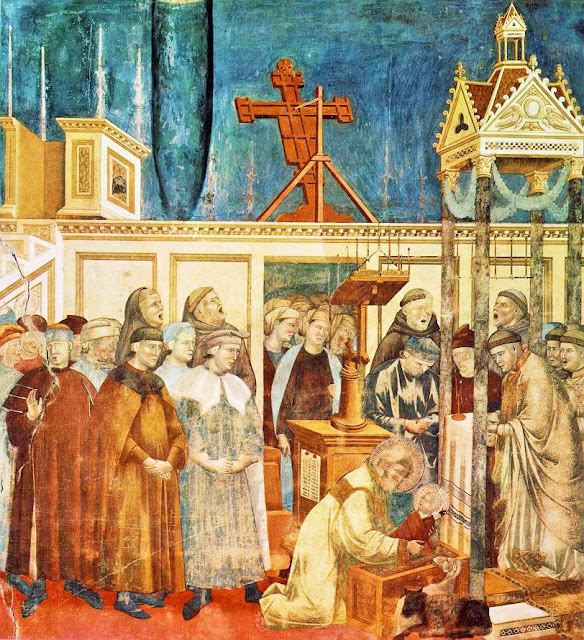Institution of the Crib by Giotto
Greccio's manger is surely the most spatially complex scene that Giotto had to face in the episodes of the life of San Francisco that figured for the Basilica of Assisi. The event takes place in the choir of a church. The wall of the rear wall closes the composition from behind, at medium height, so that we see the space that is free in the last plane. Here stands the pulpit of the church, on the left, with the typical cosmatesco decoration and, in the center, above the door that connects the two rooms, the wooden cross that gives the part of the central nave, which we do not see, yes the wooden structure of its reverse. It also helps to create the depth effect the position it adopts, clearly oblique to the plane. In the space where the episode takes place, the large number of characters that the artist has featured attracts attention. In addition, in different attitudes, which exemplifies the diverse reactions of each of them by contemplating what is happening in the foreground: to celebrate the Christmas holiday, San Francisco chose a dead child as a representation of Jesus.
When left in the manger, the boy regained his life. This is the center point of the composition. But what really gives it vitality and movement are, as we said, the reactions of those present. All of them want to participate in the celebration, but not everyone has realized the miracle. Some open their mouths, surprised, others look incredulous, some are still to come to the room, neither ecclesiastics nor lay people can believe what they are seeing. The glances help to further center the center of the representation, in two senses: while most of the eyes converge on the saint and Greccio, others raise their eyes to the cross, above, creating a parallel double diagonal between the figure of the saint. and the miracle and the image of wood, above and below. Perhaps Giotto thought it convenient to include so many characters to diversify the expression of feelings in them and prepare the festive, vital but also credible atmosphere of representation.
Saint Francis of Assisi is credited with creating the first nativity scene in 1223 at Greccio, central Italy, in an attempt to place the emphasis of Christmas upon the worship of Christ rather than upon secular materialism and gift giving. The nativity scene created by Francis is described by Saint Bonaventure in his Life of Saint Francis of Assisi written around 1260. Staged in a cave near Greccio, Saint Francis' nativity scene was a living one with humans and animals cast in the Biblical roles. Pope Honorius III gave his blessing to the exhibit.



Comments
Post a Comment